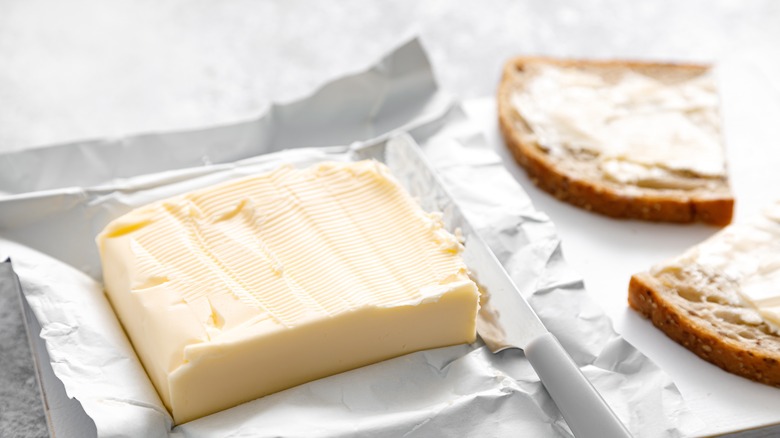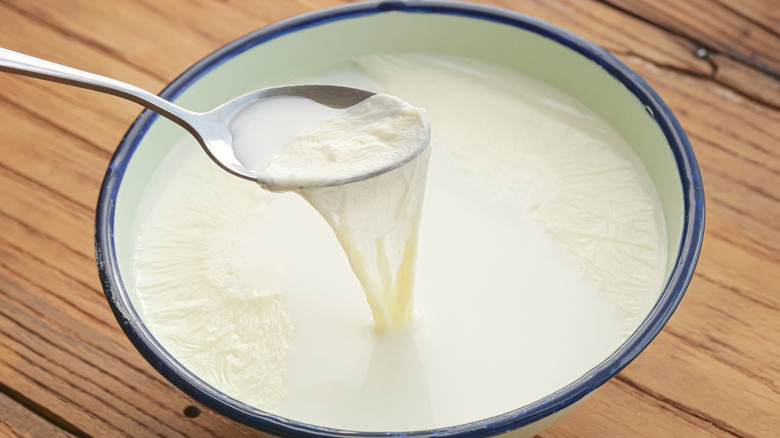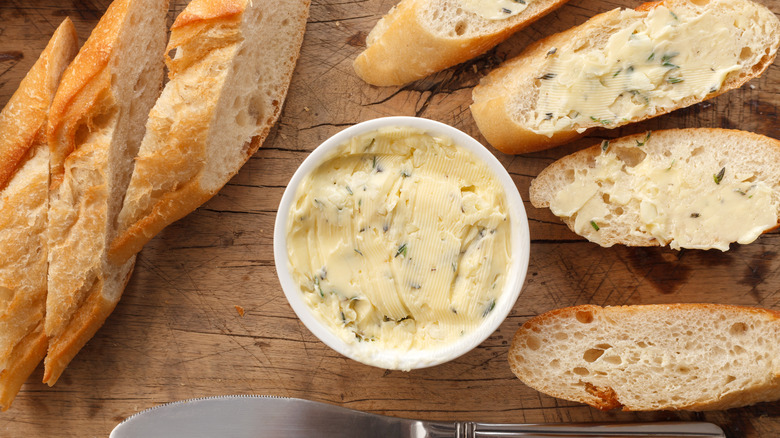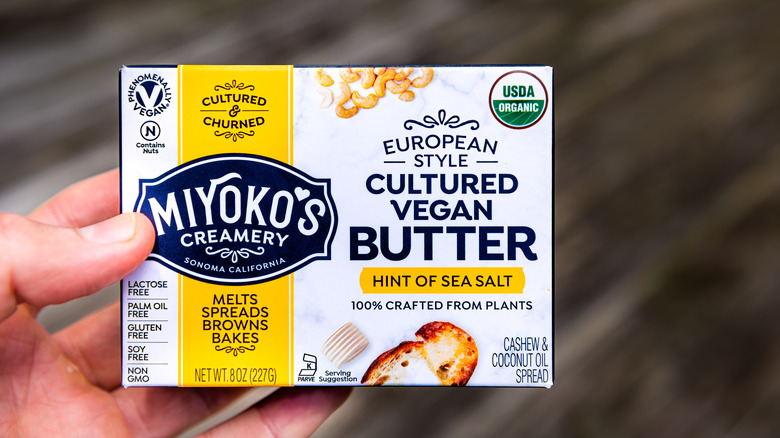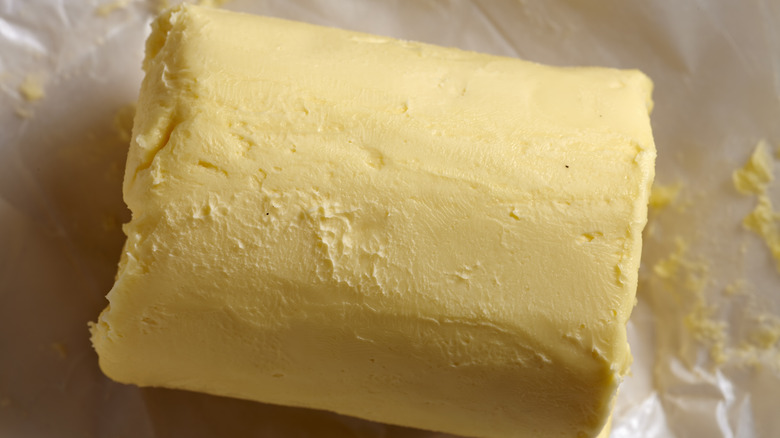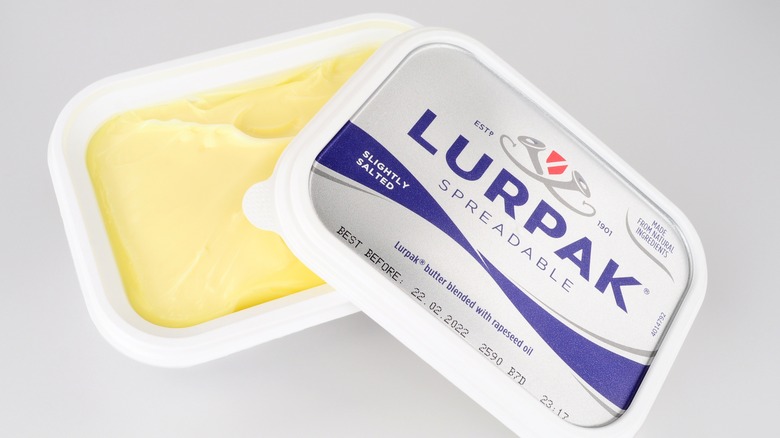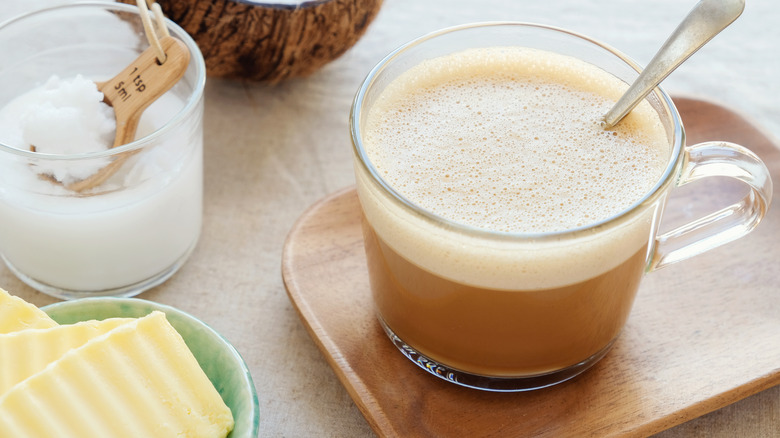18 Types Of Butter And What Each Is Used For
What do steak, crispy toast, and croissants have in common? They are all made (or made better) with butter! Butter is one of the most integral ingredients used in cooking across cuisines and regions around the world. According to the Food Network, it was believed that the first type of butter ever made was in 8000 B.C. in Africa. A shepherd likely made a journey across the continent with a satchel filled with sheep's milk. Under the hot conditions of the journey, along with the jostling movement underneath him, sheep's milk likely turned into a proto-butter. Eventually, people started using butter as a more stable dairy product from animals including yak, sheep, and goats. Since then, folks have used butter as a religious offering, as well as an integral culinary tool for cooking and baking.
But is all butter the same? Of course not! Many different types of butter have been honed through years of industrialization and processing. Here are some of the most popular types you'll find in your grocery store, along with how best to use each type.
Salted butter
Salted butter is a go-to for many American households. This type of butter is as intuitive as you think it is — standard cream butter with added salt. According to Real Baking with Rose, the National Dairy Council notes that most salted butter brands contain 1.7% to 1.8% salt by weight.
Salted butter should be reserved in your kitchen for cooking rather than baking. Baking is a delicate scientific balance of small ingredients, like salt, so adding salted butter and additional salt to your baking may skew a recipe. Also, since the amount of salt in each serving of butter can vary so much, it is hard to control how much salt you are adding to your favorite cookie recipe or buttercream frosting. In general, cooking with butter is a bit more flexible because you can add more salt as you go without upsetting other delicate balances in the recipe. Use salted butter to stir-fry your vegetables for an added boost of salty, rich flavor.
Unsalted butter
If we talk about salted butter, we also have to talk about unsalted butter. Unsalted butter does not include salt, meaning that it is just churned cream. You can find unsalted butter in the same section of your grocery store as salted butter — just make sure you read the label to pick out the one you need. Joy the Baker notes that salted butter tends to have a longer shelf life, but masks rancid flavors better than unsalted butter. If you suspect your butter has gone bad, you should smell it to see if there is an odd aroma stemming from it.
Unsalted butter should exclusively be used for baking and recipes that require a lot of care on the sodium front. You'll have greater control over how much salt is in your cookies, pies, and cakes if you use unsalted butter. The lower water content of unsalted butter is also better for the texture of baked goods. If you're cooking for an individual with a low-sodium diet, using unsalted butter will impart the same buttery flavors just without the sodium.
Whipped butter
Whipped butter should be a staple for anyone looking for the perfect accent to their French toast or morning waffle. This type of butter can be made with either salted or unsalted butter; it just has to be whipped at a fast speed to beat air into the butter. As a result, whipped butter is usually easier to spread on bread, biscuits, and everything in between. You can make whipped butter in a matter of minutes at home by adding sticks of butter to your stand mixer along with your other favorite flavorings. We recommend making spiced honey butter with cinnamon, cloves, allspice, and honey mixed in.
Whipped butter should be kept for spreading rather than baking, though some people report good results with it in cookie and pound cake recipes. Whipped butter can be hard to measure because it isn't in stick form, and it may be more prone to melting if you just finished whipping it.
Sweet cream butter
You may think that sweet cream butter implies that there is sugar involved. However, this label just means the butter is made with pasteurized milk or cream. Sweet cream butter also does not undergo fermentation, so the butter has a slightly creamier and sweeter flavor than conventional butter. Another important difference between sweet cream and regular butter is the color: regular butter contains slightly more fat, so it has a more pronounced yellow hue (via Fanatically Food). You can find both salted and unsalted varieties of sweet cream butter.
The flavor difference between sweet cream and regular butter is relatively subtle. You can use sweet cream butter for almost every use as regular butter. One of our favorite ways to use sweet cream butter, though, is to spread it on fresh summer corn on the cob. Use salted sweet cream butter to play off the sweetness of the corn and the saltiness of the butter.
Clarified butter
Clarified butter and ghee are not synonyms, but they are similar dairy products. Clarification is essentially the process that strains the butterfat from the rest of the liquids in the butter. Most butter contains around 81% butterfat, so you are trying to pull as much of the water out of the butter as possible. This can be done by heating the butter in a saucepan and removing the thin layer of foam on top of the butter as it melts.
Clarified butter has a higher smoke point than non-clarified butter, so it can be used in more high-heat applications like stir-frying. Besides the higher smoke point, clarified butter has a more profound, buttery flavor that is perfect for pairing with steamed lobster or crab, or for sprinkling on top of freshly popped popcorn. You can also use clarified butter as the basis of Hollandaise sauce — it has a much better flavor than regular butter.
Cultured butter
Cultured butter is butter that has been introduced to a bacteria culture. The inclusion of a bacterial culture help increases the flavor and tanginess of the butter without altering its texture too much. In essence, cultured butter is the opposite of American-style sweet cream butter (via Vermont Creamery). Once the bacteria have been introduced to the cream, the cream can be left to sit for as little as 24 hours before it is ready to be churned into butter. If you don't have access to live bacteria cultures at home, you can use buttermilk to make your own cultured butter instead.
Cultured butter is the ideal ingredient for finishing vegetables, bread, and appetizers. Although you can use it earlier on in the cooking process, if you want the tangy flavors to shine through, you'll want to wait to add it until the end.
Goat butter
Yes, butter can be made from more than just cows. Goat butter is made with goat's milk instead of dairy milk. Cooks Illustrated notes that goat's milk butter is typically less yellow than regular butter because goats do not consume as much beta-carotene in their diets. The flavor of this butter is milder and remains softer at room temperature than dairy butter. Some liken the texture of goat butter to shortening.
The softness of goat's milk butter makes it an ideal ingredient for butter boards and fresh applications. It is important to not use goat butter and dairy butter interchangeably in a recipe because of the difference in structure and consistency; you can end up with splat cookies or an imbalance of textures in your pie crust.
Ghee
Ghee is a cornerstone ingredient for many dishes from the Indian subcontinent. Although ghee follows the same basic steps as clarified butter, it is simmered longer and, as a result, has a darker color than clarified butter. Ghee is used in moderation in Indian and South Asian dishes including as a drizzle on chapati or as an oil to cook curried vegetables. This butter product can also be used as a stabilizer for acidic flavors in dishes and can help provide an underlying nutty flavor.
One of the misconceptions about cooking with ghee is that it can be used interchangeably with brown butter. There are no milk solids to brown when it comes to ghee since clarifying skims them off. However, ghee may be a preferred replacement for folks who cannot digest lactose. Ghee does contain trace levels of casein, though, so it may not be suitable for folks with dairy allergies (via Milkio)
European butter
European butter has a marginally higher concentration of butterfat at around 82% (compared to American butter's 80%). Although this difference might seem trivial, it does mean that European butter has a more flavorful and hyper-buttery taste. You should consider using European butter for baking pie crusts and pastries to impart a better flavor and better structure than American butter. Since European butter has lower water content, it melts faster and maintains its flavor more consistently. You'll find your crusts and laminated dough, such as for croissants, is much flakier if you use European butter.
Tinkering with the moisture and fat in your butter can be detrimental, as noted by the King Arthur Baking Company. If you're making biscuits, you'll want to stick to using plain American butter because the moisture content helps the biscuits steam up and develop the characteristic puff.
Compound butter
In short, compound butter is butter mixed with additional flavors, herbs, or seasonings. You can make a simple herb-infused compound butter at home by stirring softened butter in a bowl with chopped parsley, chives, lemon, and salt. Then, form the butter into a log on a piece of plastic wrap and seal up the ends. You can schmear this butter on a fresh baguette for an easy appetizer, or use it to complement your morning bagel.
Compound butter can also be useful for finishing steak. You can use your homemade herb compound butter or craft something a little boozier for your post-grill rituals, like a bloody Mary-inspired compound butter made by adding Worcestershire sauce and vodka. Or, add make a compound butter with a splash of whiskey, dijon mustard, shallots, and chopped parsley.
Plant-based butter
With vegan diets becoming increasingly popular in the mainstream culinary world, it isn't a surprise to see companies coming out with vegan renditions of this beloved product. The exact ingredients used for the butter depend on the brand, but most include highly saturated oils like coconut, sunflower, avocado, olive, and canola oil. Cultured vegan butter tastes and bakes just like dairy-based butter, just without the cholesterol and connection to animals.
You can use vegan butter for your side dishes, as well as for baking. Make a bowl of vegan mashed potatoes for your next Thanksgiving by adding vegan butter and dairy-free milk. You can also whip up some delicious vegan chocolate chip cookies made with a few other vegan baking replacements like dairy-free chocolate chips and powdered egg replacers.
Brown butter
There isn't a more decadent butter than brown butter. When butter is heated in a pan, the milk solids begin to caramelize, which produces tiny brown flecks of butter that change its color to a light brown and make its aroma and flavor nuttier than regular butter.
Adding brown butter is one of the easiest ways to upgrade your chocolate chip cookies. You'll get more of a toffee undertone from these cookies. We especially recommend adding caramel pieces to your cookies to amp up the flavor even more. You'll just want to be sure to cool your butter before adding it to your cookie dough to stop your cookies from spreading. You can also add brown butter to Hollandaise sauce for an upgraded eggs Benedict.
Amish butter
Amish butter is made by Amish populations in the United States without the use of modern machinery. This hand-churned butter is not only unique in its method of production but also has a higher butterfat content than both American and European butter at around 84%. As a result, Amish butter has a more profoundly milky, yet tangy flavor. If you have the opportunity to purchase Amish butter from a farmer's market or local store, you will usually see it sold in one- or two-pound logs wrapped in parchment paper.
Amish butter, like European butter, is best for applications that rely on an intense buttery flavor. Serve Amish butter with slices of crusty bread as an appetizer or slather it on your stack of pancakes in the morning.
Irish butter
Irish butter is often associated with the Kerrygold brand sold by most major grocers. Irish butter has a much yellower hue than other types of butter; this is because the cows ingest more beta-carotene into their diets, which gives their stored fat and milk a golden tint. The reason for this is that the pasture in Ireland receives high rainfall, which in turn speeds the growth of the grass the cattle graze on. Irish butter has the same amount of fat as European butter at 82%, which makes it spread easier than lower-butterfat varieties.
You'll want to use Irish butter for fresh applications and cooking alike. The color of Irish butter is super appetizing, which makes this type of butter great for making into a TikTok-inspired butter-board.
Spreadable butter
Spreadable butter and margarine are not the same things. According to Land O'Lakes, spreadable butter is made mostly of butter and contains a scant amount of oil to make it more spreadable. You'll get the same buttery taste as using a stick of butter, but with increased spreading capacity. Margarine is made with at least 80% fat from a vegetable source, animal source, or a combination of the two.
Land O'Lakes does not recommend using spreadable butter for baking because the ratio of fat and moisture would be skewed in a recipe calling for a regular stick of butter. Instead, stick to using spreadable butter for your underdone toast or for slathering below a grilled cheese to get the perfect crisp.
Smen
Smen is a type of cultured butter endemic to Morocco. NPR describes this fermented butter as "stinky," which is the result of the butter being mixed with lactic acid bacteria and stored in an airtight space for up to two years. Adding salt to smen slows some of the decomposition and maximizes the stinkiness of the butter — which, for more aged varieties, can begin to taste and smell like blue cheese. The butter can also be infused with honey, olive oil, and dried meat for flavor.
Smen is often eaten during Ramadan and on special occasions. Moroccans add butter to flavor couscous, top bread, or even upgrade their coffee. If you visit Morocco, you can find smen in supermarkets, but NPR notes this store-bought variety is usually thinner and less flavorful.
Organic butter
Organic certification is always a mystifying credential, and purchasing organic butter is no different. We should first note that the organic certification does not, in any way, impact the flavor, color, or taste of butter. USDA-certified organic butter must contain at least 95% organic ingredients; the cows milked to produce the butter also have to consume only organic feed (via Majestic Butter). USDA organic certification also prohibits the use of genetically modified organisms (GMOs) in food that is certified organic.
There are many myths and misnomers out there about buying organic products. Organic does not necessarily mean that the cows used to make the butter are grown on tiny farms on hillsides peppered with red barns. Nor does it mean that the cows have optimal quality of life. Instead, the organic certification seeks to set a prescriptive approach for what farmers can't use in terms of practices, synthetic inputs, and chemicals. This is done largely for consumer health and environmental concerns.
Grass-fed butter
Grass-fed butter all relates back to the kind of diet the cows making the milk consume. Grass-fed butter has a stronger, more intense flavor than standard butter but does not have a difference in butterfat content like Irish or European butter. There are some variations in the exact taste of the butter — which, according to Everyday Health, correlates to the location and types of grass the cows are eating.
One of the most common ways people consume grass-fed butter is by drinking it. Keto meal enthusiasts have created concoctions like bulletproof coffee, which mixes coffee with grass-fed butter and medium-chain triglyceride (MCT) oil. There is not enough evidence to suggest that this beverage has any impact on health, and there are more claims that mixing this fatty concoction actually does more harm than good to the body (via Healthline).
